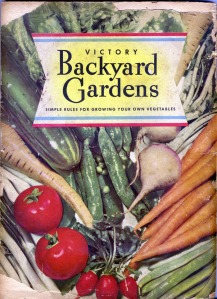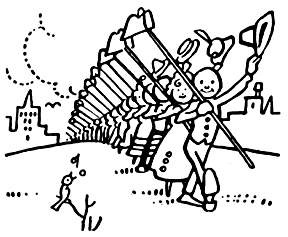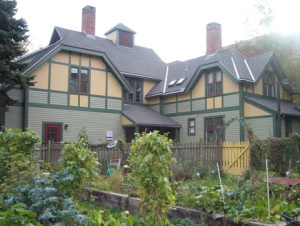Posts filed under ‘backyard gardens’
Book report: Victory Backyard Gardens (1942)
 I’ve been waylaid in the backyard, working on my vegetable garden. Some might say fruit and vegetable…there are tomatoes, tomatillos (thank you, Fox Point), cukes, peppers, and raspberries. Let ’em say what they will.
I’ve been waylaid in the backyard, working on my vegetable garden. Some might say fruit and vegetable…there are tomatoes, tomatillos (thank you, Fox Point), cukes, peppers, and raspberries. Let ’em say what they will.
A friend gave me a yardsale find: Victory Backyard Gardens: Simple Rules for Growing your own Vegetables (1942) by T.H. Everett and Edgar J. Clissold with an intro by Secretary of Agriculture Claude Wickard. He’s the one who initially told First Lady Eleanor Roosevelt that she shouldn’t plant a victory garden at the White House and later changed his tune.
Sixty-seven years later, the book gives a firsthand glimpse at how gardeners went about their task during World War II. Intensive cultivation was the key. This was the era of shortages. As gas rationing and scrap drives made Americans conserve, so they would make the most of their available land. Succession planting, minimal space between rows, etc.
Another gardener asked me what victory gardens looked like. Here’s a sample plan: This is a lot of food! I admit I had to look up what “catch crop” (a quick growing crop to plant before or after another main crop) and “hot bed” (a cold frame over a hot surface, like manure or a heating element) meant. And though fertilizer is considered a precious resource–see the bugs panel on the left–note the compost pile in one corner of the garden.
This is a lot of food! I admit I had to look up what “catch crop” (a quick growing crop to plant before or after another main crop) and “hot bed” (a cold frame over a hot surface, like manure or a heating element) meant. And though fertilizer is considered a precious resource–see the bugs panel on the left–note the compost pile in one corner of the garden.
 Finally, one of the distinctions of WWII victory gardens is that they were considered to be part of America’s Civilian Defense program. I love how the cartoon on the right encourages gardeners to share their surplus. Shouldn’t making sure your neighbor has something to eat make for a more secure community?
Finally, one of the distinctions of WWII victory gardens is that they were considered to be part of America’s Civilian Defense program. I love how the cartoon on the right encourages gardeners to share their surplus. Shouldn’t making sure your neighbor has something to eat make for a more secure community?
Providence Farm City
 Apologies to KISS…
Apologies to KISS…
Yesterday, I went to a meeting for Providence’s Urban Agriculture Task Force. Launched 4-5 years ago, it’s a confederation of state, local, non-profit, and individual representatives. Some of the projects initiated and/or completed by members include:
- installing new community gardens around the city, including sites at Sessions St. Park, Early St, Davis Park, Pearl St., Riverside Park, and more
- introducing urban agriculture in community planning meetings, the Mayor’s Green plan, and the Providence Comprehensive Plan
- launching a citywide Community Gardens Network
- developing strategies to integrate food gardens with affordable housing
- holding 50-mile meals at Mount Hope Farm, Local 121, and Providence College
- creating the RI Farm To School Project to connect local farms with school lunch programs
- planning an edible landscape (an orchard!) in Locust Grove Cemetery
- working with the RI Dept of Health and Statewide Planning to ensure that urban agriculture is in local comprehensive plans
- preparing a series of reports on Providence Urban Agriculture
Amazing projects in Providence and beyond. And more to come. If you want to get involved, contact the UATF via Southside Community Land Trust.
In the zone
 Thanks to everyone who stopped by Firehouse 13 last night for Green Zones: From the War Garden to Your Garden and the first-ever Urban Ag Spring Start Party.
Thanks to everyone who stopped by Firehouse 13 last night for Green Zones: From the War Garden to Your Garden and the first-ever Urban Ag Spring Start Party.
The talks and discussion went over really well, and the seed-swapping table was hopping. I got a chance to connect with gardeners, historians, and gardening historians from all over.
A spring party was a great outlet for gardeners with seeds, plants, and stories to share. As RI’s food gardening network continues to grow, imagine another garden event this fall?!?!?!?!
Hope gardens: it’s time (again)
 Hats off to Providence Journal Business editor John Kostrzewa for today’s column on “A seed of hope and easy to plant.” Kostrzewa suggests that in this time of economic crisis, hope is in short supply. While we work on the big-picture, long-term, structural fixes, why not engage in a more immediate way to improve Rhode Island: “Dedicate plots of land throughout the state for community gardens.”
Hats off to Providence Journal Business editor John Kostrzewa for today’s column on “A seed of hope and easy to plant.” Kostrzewa suggests that in this time of economic crisis, hope is in short supply. While we work on the big-picture, long-term, structural fixes, why not engage in a more immediate way to improve Rhode Island: “Dedicate plots of land throughout the state for community gardens.”
His column puts forward a number of initiatives that may seem groundbreaking, but they all have precedents in Rhode Island’s recent history. For instance:
“How about using some of the highly visible sloping land that runs away from the State House. Or what about the 4.5 acres across the street from the Amtrak station.”
Done: Around 1920-21, the Rhode Island Normal School had a demonstration school garden on its grounds southwest of the State House–where Providence Place Mall stands today (see photo above).
“Make community gardens a statewide project. Make it a competition among each of the cities and towns to design and plant their own plots.”
Done: In 1916, Governor R. Livingston Beeckman initiated an annual garden contest among mill towns. Prizes were awarded for best vegetable garden, garden, and village appearance.
“Pick the sites from available public land.”
Done. In 1908, the city installed school gardens at Roger Williams Park. In 1943, the RI Senate passed a resolution “to formulate and promulgate a plan and program of procedure for the state of Rhode Island victory gardens upon state-owned land.”
“The seeds and plants can be donated.”
Done: In 1908, Congressman Daniel Granger secured donations of seeds for the Roger Williams Park school gardens. In 1932, RI Congressmen arranged for the US Dept. of Agriculture to distribute seeds to RI gardeners.
“Once the gardens have been planted, turn over the maintenance to service organizations, such as the scouts or fraternal groups.”
Done: During World War I, local organizations that participated in the War Garden movement included: RI Horticultural Society, Providence Housewives League, RI Boy Scouts (who guarded the gardens), and the League of Improvement Societies–not to mention dozens of factories and schools.
“And with so many unemployed people, let them work in a garden until they find a job.”
Done: During the Great Depression, state and local governments organized a statewide subsistence garden program of “private backyard gardens, vacant lot gardens, community plots divided into individual gardens, industrial gardens, industrial gardens for part-time workers, and community gardens not divided into individual plots but worked by unemployed men in return for food orders.”
As Kostrzewa notes, we’re on our way, thanks to the work of groups like Southside Community Land Trust and the Children’s Garden Network. I’ll add my two cents: just look to the past to learn how green Rhode Island can be.
Bibliographic note: The photograph of the demonstration garden at the RI Normal School comes from the League of Improvement Societies in RI Year Book for 1920-21. All other historical information derived from articles in the Providence Journal, 1906-1943.
Green thoughts on garden plots
 Brown University’s Center for Environmental Studies not only hosts a community garden for staff, students, and neighbors, but it also supports scholarship on gardening. Two Environmental Studies grad students are studying the impact of local food gardening. They are defending their masters theses next week, and the public is invited to attend.
Brown University’s Center for Environmental Studies not only hosts a community garden for staff, students, and neighbors, but it also supports scholarship on gardening. Two Environmental Studies grad students are studying the impact of local food gardening. They are defending their masters theses next week, and the public is invited to attend.
Monday, April 13th at noon
Marie-Laure Couët on “Strengthening Providence with Community Gardens”
Tuesday, April 14 at 10am
Nora Buckman on “The Grass isn’t Greener: Exploring the Motivations and Barriers to Home Gardening in Rhode Island”
Both presentations take place at the Urban Environmental Lab, 135 Angell Street. Visit the garden if you stop by.